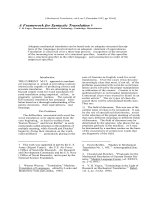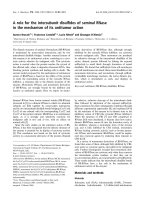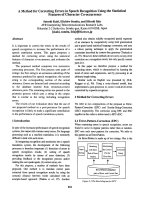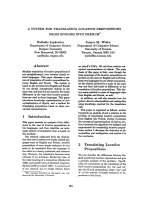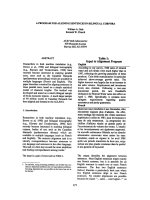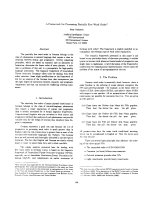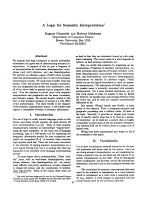Báo cáo khoa học: "A TOOLKIT FOR LEXICON BUILDING" pdf
Bạn đang xem bản rút gọn của tài liệu. Xem và tải ngay bản đầy đủ của tài liệu tại đây (715.51 KB, 9 trang )
A TOOL KIT FOR LEXICON BUILDING
Thomas E. Ahlswede
Computer Science Department
Illinois Institute of Technology
Chicago, Illinois 6e616, USA
ABSTRACT
This paper describes a set of
interactive routines that can be used to
create, maintain, and update a computer
lexicon. The routines are available to
the user as a set of commands resembling a
simple operating system. The lexicon pro-
duced by this system is based on lexi-
cal-semantic relations,
but
is compatible
with a variety of other models of lexicon
structure. The lexicon builder is suit-
able for the generation of moderate-sized
vocabularies and has been used to
construct a lexicon for a small medical
expert system. A future version of the
lexicon builder will create a much larger
lexicon by parsing definitions from
machine-readable dictionaries.
INTRODUCTION
Natural language processing systems
need much larger lexicons than those
available today. Furthermore, a good com-
puter lexicon with semantic as well as
syntactic information is elaborate and
hard to construct. We have created a
program which enables its user to inter-
actively build and extend a lexicon. The
program sets up a user environment similar
to a simple interactive operating system;
in this environment lexical entries can be
produced through a small set of commands,
combined with prompts specified by the
user for the desired kind of lexicon.
The interactive lexicon builder is
being used to help construct entries for a
lexicon to be used to parse and generate
stroke case reports. Many terms in this
medical sublanguage either do not appear
in standard dictionaries or are used in
the sublanguage with special meanings.
The design of the lexicon builder is
inuended to be general enough to make it
useful for others building lexicons for
large natural language processing systems
involving different sublanguages.
The interactive lexicon builder will
be the basis for a fully automatic lexicon
builder which uses Sager's Linguistic
String Parser (LSP) to parse machine-
readable text into a relational network
based on a modified version of Werner's
NTQ (Modification-Taxonomy-Queueing)
schema. Initially this program will be
applied to Webster's Seventh Collegiate
Dictionary and the Longman Dictionary of
Contemporary English, both of which are
available in machine-readable form.
LEXICAL-SENANTIC RELATIONS
The semantic component of the lexicon
produced by this system consists princi-
pally of a network of lexical-semantic
relations. That is, the meaning of a word
in the lexicon is indicated as far as
possible by its relationships with other
words. These relations often have seman-
tic content themselves and thus contribute
to the definition of the words they link.
The two most familiar such relations
are synonymy and antonymy, but others are
interesting and important. For instance,
to take an example from the vocabulary of
stroke reports, the carotid is a kind of
artery and an artery is a kind of blood
Vessel. This "is a kind of" relation is
taxonomy. We express the taxonomic rela-
tions of "carotid', "artery" and "blood
vessel" with the relational arcs
carotid T artery
artery T blood vessel
Another important relation is that of
the part to the whole:
ventricle PART heart
Broca's area PART brain
Note that taxonomy is transitive: if
the carotid is an artery and an artery is
a blood vessel,
then
the carotid is a
blood vessel. The presence or absence of
the properties of transitivity, reflexiv-
ity and symmetry are important in using
relations to make inferences.
268
The part-whole relation is more
complicated than taxonomy in its proper-
ties; some instances of it are transitive
and others are not. From this and other
criteria, Iris et al. (forthcoming)
distinguish four different part-whole
relations.
Taxonomy and part-whole are very
common relations, by no means restricted
to any particular sublanguage. Sublan-
guages may, however, use relations that
are rare or nonexistent in the general
language. In the stroke vocabulary, there
are many words for pathological conditions
involving the failure of some physical or
mental function. We have invented a rela-
tion NNABLE to express the connection
between the condition and the function:
aphasia NNABLE speech
amnesia NNABLE memory
Relations such as T, PART, and NNABLE
are especially useful in making infer-
ences. For instance, if we have another
relation FUNC, describing the typical
function of a body part, we might combine
the relational arc
speech FUNC Broca's area
with the arc
aphasia NNABLE speech
to infer that when aphasia is present, the
diagnostician should check for the possl-
bility of damage to Broca's area (as well
as to any other body part which has speech
as a function).
Figure i. Part of a relational network
Another kind of relation is the "col-
locational relation', which governs the
combining of words. These are particu-
larly useful for generating idiomatic
text. Consider the "typical preposition"
relation PREP:
on PREP list
which says that an item may be "on a list"
as opposed to "in a list" or "at a list."
Although the lexicon builder is based
on a relational model, it can be adapted
for use in connection with a variety of
models of lexicon structure. A semantic-
field approach can be handled by the same
mechanism as relations; the lexicon
builder also recognizes unary attributes
of words, and these attributes can be
treated as semantic features if one wishes
to build a feature-based lexicon.
APPLICATIONS FOR THE LEXICON BUILDER
This project was motivated partly by
theoretical questions of lexicon design
and
partly by projects which required the
use of a lexicon.
For instance, the Michael Reese Hos-
pital Stroke Registry includes a text
generation module powered by a relational
lexicon (Evens et al., 1984). This appli-
cation provided a framework of goals
within which the interactive lexicon
builder was developed. The vocabulary
required for the Stroke Registry text
generator is of moderate size, about 2000
words and phrases. This is small enough
thau a lexicon for it can be built
interactively.
One can imagine many applications for
a large lexicon
such
as the automatic
lexicon builder will construct. Question
answering is one of our original areas of
interest; a large, densely connected
vocabulary will greatly add to the variety
of inferences a question answering system
can make. Another area is information re-
trieval, where experiments (Evens et al.,
forthcoming) have shown that the use of a
relational thesaurus leads to improvements
in both recall and precision.
On a more theoretical level, the
automatic lexicon builder will add greatly
to our understanding of sublanguages,
notably that of the dictionary itself. We
have noted that a specialized relation
such as NNABLE,
unusual
in the general
language, may be important in a sub-
language. We believe that
such
specific
relations are part of the distinctive
character of every sublanguage. The very
possibility of creating a large, general-
269
language lexicon points toward a time when
sublanguages will be obsolete for many of
the purposes for which they are now used;
but they will still be useful and
interesting for a long time to come, and
the
automatic
lexicon builder gives us a
new tool for analyzing them.
THE INTERACTIVE LEXICON BUILDER
Commands
The interactive lexicon builder
consists of an operatlng-system-like
environment in which the user may invoke
the following commands:
HELP displays a set of one-line
summaries
of the commands, or a paragraph-
length description of a specified command.
This paragraph describes the command-line
arguments, optional or required, for the
given command, and briefly explains the
function of the command.
ADDENTRY provides a series of prompts
to enable the user to create a lexical
entry. Some of these prompts are hard
coded; others can be set up in advance by
the user so that the lexicon can be
tailored to the user's needs.
EDIT enables the user to modify an
existing entry. It displays the existing
contents of the entry item by item,
prompting for changes or additions. If
the desired entry is not already in the
lexicon, EDIT behaves in the same way as
ADDENTRY.
DELETE lets the user delete one or
more entries. An entry is not physically
deleted; it is removed from the direc-
tory, and all entries with arcs pointing
to it are modified to eliminate those
arcs. (This is simple to do, since for
every such arc there is an inverse arc
pointing to that entry from the deleted
one.) On the next PACK operation (see
below) the deleted entry will not be
preserved in the lexicon.
This command can also be used to
delete the defective entries that are
occasionally caused by unresolved bugs in
the entry-creating routines, or which
might arise from other circumstances. A
special option with this command searches
the directory for a variety of "illegal"
conditions such as nonprinting characters,
zero-length names, etc.
LIST gives one-line listings of some
or all of the entries in the lexicon. The
listing for each entry includes the name
(the word itself), sense number, part of
speech, and the first forty characters of
the definition if there is one.
SHOW displays the full contents of
one or more entries.
RELATIONS displays a table of the
lexical-semantic relations used by the
lexicon builder. This table is created by
the
user
in a separate operation.
UNDEF is a special form of EDIT. In
creating an entry, the
user
may create
relational arcs from the current word to
other words that are not in the lexicon.
The system keeps a queue of undefined
words. UNDEF invokes EDIT for the word at
the head of the queue, thus saving the
user the trouble of looking up undefined
words.
PACK performs file management on the
lexicon, sorting the entries and elimi-
nating space left by deleted ones.
This routine works in two passes. In
the first pass, the entries are copied
from the existing lexicon file to a new
file in lexicographic order and a table is
created that maps the entries from their
old locations to their new ones. At this
stage, a relational arc from one entry to
another still points to the other entry's
old location. The second pass updates the
new lexicon, modifying all relational arcs
to point to the correct new locations.
QUIT exits from the lexicon builder
environment. Any new entries or changes
made during the lexicon building session
are incorporated and the directory is
updated.
Extensions
to
the
commands
All of the commands can be abbrevi-
ated; so far they all have distinctive
initials and can thus be called with a
single keystroke.
Each command may be accompanied by
command-line arguments to define its ac-
tion more precisely. Display commands,
such
as HELP or SHOW, allow the user to
get a printout of the display. Where an
entry name is to be specified, the user
can get more than one entry by means of
"wild cards." For instance, the command
"LIST produc= might yield a list showing
entries for "produce', "produced", "pro-
duces", "producing', "product', and
"production. ~
Additional commands are currently
being developed to help the user manage
the relation table and the attribute list
from within the lexicon builder
environment.
270
The design of the user interface took
into account both the available facilities
and the expected users. The lexicon
builder runs on a VAX 11-75B, normally
accessed with line-edlting terminals.
This suggests that a single-line command
format is most appropriate. Since much of
the work with the system is done over 3~0
baud telephone lines, conciseness is also
important. The users have all had some
programming experience (though not neces-
sarily very much) so an operating-system-
like interface is easy for them to get
used to. If the lexicon builder becomes
popular, we hope to have the opportunity
to develop a more sophisticated interface,
perhaps with a combination of features for
beginners and more experienced users.
Structure of a lexlcal entry
A complete lexical entry consists of:
i. The
"name"
of the entry its
character-string form.
2. Its sense. We represent senses
by simple numbers, not attempting to
formally distinguish polysemy and homo-
nymy, or any other degree of semantic
difference. The system leaves to the user
the problem of distinguishing different
senses from extensions of a single sense:
that is, where a word has already been
entered in some sense, the user
must
decide whether to modify the entry for
that sense or create a new
entry
for a new
sense.
3. Part of speech, or "class." Our
classification of parts of speech is
basically the traditional classification
with some convenient additions, largely
drawn from the classification used by
Sager in the LSP (Sager, 1981). Most of
the additions are to the category of
verbs: "verb" to the lexicon builder de-
notes the stem form, while the third
person and past tense are distinguished as
"finite verb', and the past and present
participles are classified separately.
4. The text of the definition,
entered by the user.
At this stage in our work, the
definition is not parsed or otherwise ana-
lyzed, so its presence is more for
purposes of documentation than anything
else. In future versions of the lexicon
builder, the definition will play an
important role in constructing the entry
but in the entry itself will be replaced
by information derived from its analysis.
5. A list of attributes (or semantic
features), each with its value, which may
be binary or scalar.
6.
A predicate calculus definition.
For example, for the most common sense of
the verb "promise', the predicate calculus
definition is expressed as
promiseix,y,z)
=
say(x,w,z)
_eventiy) => w
=
will happen(y)
_thing(y) => w
=
will receive(z,y)
or, in freer form,
ix promises y to z}
=
ix says w to z)
where w
=
(y will happen)
if y is an event
(z will receive y)
if y is a physical object.
This is entered by the user.
We have been inclined to think of the
relational lexicon as a network, since the
network representation vividly brings
out
the interconnected quality which the
relational model gives to the lexicon.
Predicate calculus is better in other
respects; for instance, it expresses the
above definition of "promise" much more
elegantly than any network notation could.
The two methods of representation have
traditionally been seen as alternatives
rather than as supplementing each other;
we believe that predicate calculus has an
important supplementary role to play in
defining the core vocabulary of the
lexicon, although we are not sure yet how
to use it.
7. Case structure (for verbs). This
is a table describing, for each syntactic
slot associated with the verb (subject,
direct object, etc.) the semantic case or
cases that may be used in that slot
('age,in, "experiencer', etc.), whether it
is required, optional, or may be expressed
elliptically (as with the direct and
indirect object in "I promisei" referring
to an earlier
statement).
Space is reserved in this structure
for selection restrictions. A relational
model gives us the much more powerful op-
tion of indicating through relations such
as "permissible subject', "permissible
object', etc., not only what words may go
with what others,
but
whether the usage is
literal, a conventional figure of speech,
fanciful, or whatever. Selection restric-
tions do, however, have the virtue of
conciseness, and they permit us to make
generalizations. Relational arcs may then
be used to mark exceptions.
8. A list of zero or more relations,
each with one or more pointers to other
entries, to which the current entry is
connected by that relation.
271
We find it convenient to treat mor-
phological derivations such as plural of
nouns, tenses and participles of verbs, as
relations connecting separate entries.
The entry for a regularly derived form
such as a noun plural is a minimal one,
consisting of name, sense, part of speech,
and one relational arc, linking the entry
to the stem form. The lexicon builder
generates these regular forms automati-
cally. It also distinguishes these "regu-
lar" entries from "undefined" entries,
which have been entered indirectly as
target words of relational arcs and which
are on the queue accessed by UNDEF, as
well as from "defined" entries.
name
sense
class
text of
definition
attribute list
predicate
calculus
definition
case structure
table
relation~
list
w2-
I
w2 1.2[
l :I
Figure 2, Structure of a lexical entry
File structure of the lexicon
There are four data files
wi~h the lexicon.
associated
The first is the lexicon proper. The
biggest complicating factor in the design
of the lexicon is the extremely inter-
connected nature of the data; a change in
one portion of the file may necessitate
changes in many other places in the file.
Each entry is linked through relational
arcs to many other entries; and for every
arc pointing from wordl to word2, there
must be an inverse arc from word2 to
wordl. This means that whenever we create
a new arc in the course of building or
modifying an entry for wordl, we must
update the entry for word2 so that it will
contain the appropriate inverse arc back
to wordl• Word2~s entry has to be updated
or created from scratch; we need to
structure the lexicon file so that this
updatin9 process, which may take place
anywhere in the file, can be done with the
least possible dislocation.
aphasia (1) n.
definition
a disorder of language due to injury
to the brain
attributes
nonhuman
collective
predicate calculus
have(x, aphasia) "able(speak(x))
relations
TAX
[aphasia is a kind of x]
deficit
disorder
loss
inability
"TAX
Ix is a kind of aphasia]
anomic
global
gerstmann ' s
semantic
We rnicke ' s
Sroca ' s
conduction
transcortical
SYMPTOM
[aphasia is a symptom of x]
stroke
TIA
ASSOC
[aphasia may be associated with x]
apraxia
_CAUSE
[x is a cause of aphasia]
injury
lesion
NNABLE
[aphasia is the inability to do x]
speech
language
Figure 3. Lexical entry for "aphasia"
The size of an entry can vary
enormously. Regular derived forms contain
only the name, sense, class and one rela-
tional arc (to the stem form), as well as
a certain amount of overhead for the
definition, predicate calculus definition
and attribute list although these are not
used. The smallest possible entry takes
up about thirty bytes. At the other
extreme, a word may have an extensive
attribute list, elaborate
text
and
predicate calculus definitions, and dozens
272
or even (eventually) hundreds of rela-
tional arcs. "Aphasia', a moderately
large entry with 19 arcs, occupies 322
bytes. Like all entries in the current
lexicon, it will be subject to updating
and will certainly become much larger.
With this range of entry sizes, the
choice between fixed-size and variable-
size records becomes somewhat painful.
Variable-size records would be highly
convenient as well as efficient except for
the fact that when we add a new entry that
is related to existing entries, we must
add new arcs to those entries. The
existing entries
thus
no longer fit into
their previous space and must be either
broken up or moved to a new space. The
former option creates problems of
identifying the various pieces of the
entry; the latter requires that yet
more
existing entries be modified.
Because of these problems, we have
opted for a fixed-size record. Some space
is wasted, either in empty space if the
record is too large or through prolifera-
tion of pointers if the record is too
small; but the amount of necessary up-
dating is much less, and the file can be
kept in order through frequent use of
the
PACK command. The choice of record size
is conditioned by many factors, system
requirements as well as the range of entry
sizes. We are currently working on deter-
mining the best record size for the MRH
application.
So far the user does not have the op-
tion of saving or rejecting the results of
a lexicon building session, since entries
are written to the file as soon as they
are created. We are studying ways of
providing this option. A brute force way
would be to keep the entire lexicon in
memory and rewrite it at the end of the
session. This is feasible if the host
computer is large and the lexicon is
small. The 2~g0-word lexicon for the
Michael Reese stroke database takes up
about a third of a megabyte, so this
approach would work on a mainframe or a
large minicomputer such as our Vax 75g,
but could not readily be ported to a
smaller machine; nor could we handle a
much larger vocabulary such as we plan to
create with the automatic lexicon builder.
The second file is a directory,
showing each entry's name, sense, and
status (defined, undefined or regular
derivauive), with a pointer to the appro-
priate entry in the lexicon proper. The
directory entries are linked in lexico-
graphic order. When the lexicon builder
is invoked, the entire directory is read
into a buffer in memory, and this buffer
is update~ as entries are created,
modified or deleted. At the end of a
lexicon building session, the updated
directory is written out to disk.
The third (optional) file is a table
of attributes, with pointers into the
lexicon proper. This can be extended into
a feature matrix.
The fourth (also optional) is a table
of pre-defined relations. This table
includes, for each relation:
(i) its mnemonic name.
(2) its properties. A relation may
be reflexive, symmetric or transitive;
there may
be
other properties worth
including.
(3) a pointer to the relation's
inverse. If x REL y, then we can define
some REL such that y REL x. If REL is
reflexive or symmetric, then REL = REL.
(4) the appropriate parts of speech
for the words linked by the relation. For
instance, the NNABLE relation links two
nouns, while the collocational PREP rela-
tion links a preposition to a noun.
Taxonomy can link any two words (apart
from prepositions, conjunctions, etc.) as
long as they are of the same part of
speech: nouns to nouns, verbs to verbs,
etc.
(5) the text of a prompt. ADDENTRY
uses this prompt when querying the user
for the occurrence of relational arcs
involving this relation. For instance, if
we are entering the word "promise" and our
application uses the taxonomy relation, we
might choose a short prompt, in which case
the query for taxonomy might take the form
"promise" T: [user enters word2 here]
or we could use something more explicit:
"promise" is a kind of:
Users familiar with lexical-semantic
relations might prefer the shorter
mnemonic prompt, whereas other users might
prefer a prompt that better expressed the
significance of the relation.
THE AUTOMATIC LEXICON BUILDER
Building a very large lexicon
There are numerous logistical prob-
lems in implementing the sort of very
73
large lexicon that would result from anal-
ysis of an entire dictionary, as the work
of Amsler and White (1979) or Kelly and
Stone (1975) shows. Integrating the
lexicon builder with the LSP, and writing
preprocessors for dictionary data, will
also be big jobs. Fully automatic analy-
sis of dictionary material, then, is a
long-range goal.
A major problem in the relational
analysis of the dictionary is that of
determining what relations to use. Noun
and verb definitions rely on taxonomh ~ to a
great extent (e.g. Amsler and White,
1979) but there are definitions that do
not clearly fit this pattern; further-
more, even in a taxonomic definition, much
semantic information is contained in the
qualifying or differentiating part of the
definition.
Adjective definitions are another
problem area. Adjectives are usually
defined in terms of nouns or verbs rather
than other adjectives, so simple taxonomy
does not work neatly. In a sample of
about 7,0~ definitions from W7, we
identified nineteen major relations unique
to adjective definitions, and these
covered only half of the sample. The
remaining definitions were much more
varied and would probably require far more
then nineteen additional relations. And
for each relation, we had to identify
words or phrases (the "defining formulas')
that signaled the presence of the
relation.
The
M'~
model
For these reasons as well as
theoretical ones, we need a simplifying
model of relations, a model that enables
us either to avoid the endless identifica-
tion of new relations or to conduct the
identification within an orderly frame-
work. Werner's MTQ schema (Werner, 1978;
Werner and Topper, 1976) seems to provide
the basis for such a model.
Werner idennifies only three rela-
tions: modification, taxonomy and queue-
ing. He asserts that all other relations
can be expressed as compounds of these
relations and of lexical items for
instance, the PART relation can be
expressed, with the help of the lexical
item "part', by the relational arcs
Broca's area T part
brain M part
which say in effect that Broca's area is a
kind of part, specifically a "brain-part."
werner's concept of modification and
taxonomy reflects Aristotle's model of the
definition as consisting of species, genus
and differentiae taxonomy links the
species to the genus and modification
links the differentiae to the genus. A
study of definitions in W7 and LDOCE shows
that they do indeed follow this pattern,
although (as in adjective definitions) the
pattern is not always obvious.
The special power of MTQ in the
analysis of definitions is that in a
definition following the Aristotelian
structure,
taxonomy and modification can
be identified by purely syntactic means.
One (or occasionally more than one) word
in the definition is modified directly or
indirectly by all the other words. The
core word is linked to the defined word by
taxonomy; all the others are linked to
the core word by modification. (Queueing
so far does not seem to be important in
the analysis of definitions.)
In order to avoid certain ambiguities
that arise in a very elaborate network
such as that generated from a large dic-
tionary, we have replaced the separate
modification and taxonomy arcs with a
single, ternary relational arc that keeps
the species, genus and differentiating
items of any particular definition linked
to each other.
The problem of identifying "higher
level" relations such as PART and NNABLE
in an MT0 network still remains. At this
point it seems to be similar to the prob-
lem of identifying higher level relations
from defining formulas.
Another pleasant discovery is that
the Linguistic String Parser, which we
have used successfully for some years, is
exceptionally well suited for this strat-
egy, since it is geared toward an analysis
of sentences and phrases in terms of
"centers" or "cores" with their modifying
"adjuncts', which is exactly the kind of
analysis we need to do.
Design of the automatic lexicon builder
The automatic lexicon builder will
contain at least the following suDsystems:
I. The standard data structure
for
the lexical entry, as described for the
interactive lexicon builder, with slight
changes to adjust to the use of MTQ.
The relation list is presently
structured as a linked list of relations,
each pointing to a linked list of wordis.
('Wordi" refers to any word related to the
274
word (=wordl') we are currently investi-
gating.) Incorporating the ternary MTQ
model, we would have two relation lists:
a T list and an M list. The T list would
be a linked list of words connected to
wordl by the T relation; its structure
would be identical to the present relation
list except that its nodes would be
lexical entry pointers instead of rela-
tions. Each of these lexical entry point-
ers would, like the relation nodes in the
existing implementation, point to a linked
list of word2s. The word2s in the T list
would be connected to the T words by an
inverse-modification relation ('M) and the
word2s in the M list would be connected to
the M words by inverse taxonomy ('T).
2. Preprocessors to convert pre-
existing data to the standard form. The
preprocessor need not be intelligent; its
job is to identify and decode part-of-
speech and other such information, sepa-
rating this from the definition proper.
Part of the preprocessing phase is to
generate a "dictionary" for the LSP. This
dictionary need only contain part-
of-speech information for all the words
that will be used in definitions; other
information such as part- of-speech
subclass and selection restrictions is
helpful but not necessary. Sager and her
associates (198B) have created programs to
do this.
3. Batch and interactive input
modules. The batch input reads a data
file in standard form, perhaps optionally
noting where further information would be
especially desirable. The interactive
input is preserved from the interactive
version of the system and allows the user
to "improve" on dictionary data as well as
to observe the results of the dictionary
parse.
4. Definition analyzer. In this
module, the LSP will parse the definition
to produce a parse tree. which will then
be converted into an MTQ network to be
linked into the overall lexical network.
5. Entry generator. This module,
like the preprocessor, can be tailored to
the user's needs.
SU~X
A program has been written that
enables a user interested in creating a
lexicon for natural language processing to
generate lexical entries interactively and
link them
automatically
to other lexical
entries through
lexical-semantic
rela-
tions. The program provides a small set
of commands
that
allow the user to create,
modify, delete, and display lexical
entries,
among other operations.
The immediate motivation for the
program was to produce a relational
lexicon for text generation of clinical
reports by a diagnostic expert system. It
is now being used for that purpose. It
can equally well be used in any other sub-
language environment; in addition, it is
intended to be compatible, as far as
possible, with models of lexicon structure
other than the relational model on which
it is based.
The interactive lexicon builder is
further intended as the starting point for
a fully automatic lexicon building program
which will create a large, general purpose
relational lexicon from machine readable
dictionary text, using a slightly modified
form of Werner's Modification-Taxonomy-
Queueing
relational model.
REFERENCES
Ahlswede, Thomas E., and Evens, Martha W.,
1983. "Generating a Relational Lexicon
from a Machine-Readable Dictionary."
Proceedings of the Conference on
Artificial Intelligence, Oakland Univer-
sity, Rochester, Michigan.
Ahlswede, Thomas E., and Evens, Martha W.,
1984. "A Lexicon for a Medical Expert
System." Presented at the Workshop on
Relational Models, Coling '84, Stanford
University, Palo Alto, California.
Ahlswede, Thomas E., in press. =A Lin-
guistic String Grammar of Adjective
Definitions." In S. Williams, ed. Humans
and Machines: The Interface Through
Language, Ablex.
Amsler, Robert A., and White, John S.,
1979. Development of a Computational
Methodology for Deriving Natural Language
Semantic Structures via Analysis of
Machine Readable Dictionaries. Linguis-
tics Research Center, University of Texas.
Evens, Martha W., Ahlswede, Thomas E.,
Hill, Howard, and Li, Ping-Yang, 1984.
"Generating Case Reports from the Michael
Reese Stroke Database." Proc. 1984
Conference on Intelligent Systems and
Machines, Oakland University, Rochester,
Michigan, April.
Evens, Martha W., Vandendorpe, James, and
Wang, Yih-Chen, in press. "Lexical-
Semantic Relations in Information Retriev-
al," In S. Williams, ed. Humans and
Machines: The Interface Through Language,
Ablex.
275
Iris, Madelyn, Litowitz, Bonnie, and
Evens, Martha W., unpublished. "The
Part-Whole Relation in the Lexicon: an
Investigation of Semantic Primitives."
Kelly, Edward F., and Stone. Philip J.,
1975. Computer Recognition of English
Word Senses. North-Holland, Amsterdam.
Sager, Naomi, 1981.
Information Processing.
New York.
Natural Language
Addison-Wesley,
Sager Naomi, Hirschman, Lynette, White,
Carolyn, Foster, Carol, Wolff, Susanne,
Grad, Robert, and Fitzpatrick, Eileen,
198~. Research into Methods for Automatic
Classification and Fact Retrieval in
Science Subfields. String Reports No.
13, New York University.
Werne~, Oswald, 1978. "The Synthetic
Informant Model: the Simulation of Large
Lexical/Semantic Fields." In M. Loflin
and J. Silverberg, eds., Discourse and
Difference in Cognitive Anthropology.
Mouton, The Hague.
Warner, Oswald, and Topper, Martin D.,
1976. "On the Theoretical Unity of
Ethnoscience Lexicography and Ethnoscience
Ethnographies." In C. Rameh, ed., Seman-
tics, Theory and Application, Proc.
Georgetown University Round Table on
Language and Linguistics.
276

